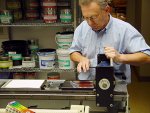Hello,
We sell accessory products worldwide that are manufacturered in China in order to compete in the US and worldwide market. Unforunately that means that all of our packaging is also printed in China. Our packaging is 2-colors (black plus our brand color which is a PANTONE spot color). I have set up my pantone spot color with the correct color in adobe illustrator. The printer confirmed back the same pantone spot color that is in my artwork as what they are using. They also claim they are purchasing a pre-mixed spot color from a licensed pantone ink manufactuer. Pantone's licensing dept also verified the ink manufacturer they are using is licensed in commercial off-set printing inks and are in good standing. Yet the color on the packaging samples does not match the pantone chip that I tore out of the Pantone Solid chips book, or the pantone color formula guide. I have a new book, and tore off a new chip. Yet the packaging samples still do not match. The hue is a different color. Now, I'm not a printer, I'm a graphic designer, but it looks to me that it is mixed wrong (has too much of one of the colors in the formula, not enough of the other). The printer insists they are not mixing the ink themselves, but are purchasing the inks from a manufacturer. Does anyone have any experience with this? What else can make the pantone spot color be wrong? Is there any other possibility besides a bad ink mix?
We sell accessory products worldwide that are manufacturered in China in order to compete in the US and worldwide market. Unforunately that means that all of our packaging is also printed in China. Our packaging is 2-colors (black plus our brand color which is a PANTONE spot color). I have set up my pantone spot color with the correct color in adobe illustrator. The printer confirmed back the same pantone spot color that is in my artwork as what they are using. They also claim they are purchasing a pre-mixed spot color from a licensed pantone ink manufactuer. Pantone's licensing dept also verified the ink manufacturer they are using is licensed in commercial off-set printing inks and are in good standing. Yet the color on the packaging samples does not match the pantone chip that I tore out of the Pantone Solid chips book, or the pantone color formula guide. I have a new book, and tore off a new chip. Yet the packaging samples still do not match. The hue is a different color. Now, I'm not a printer, I'm a graphic designer, but it looks to me that it is mixed wrong (has too much of one of the colors in the formula, not enough of the other). The printer insists they are not mixing the ink themselves, but are purchasing the inks from a manufacturer. Does anyone have any experience with this? What else can make the pantone spot color be wrong? Is there any other possibility besides a bad ink mix?
Last edited:













